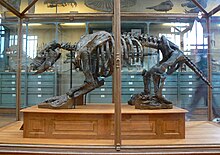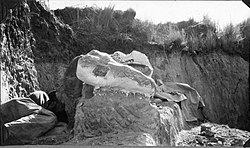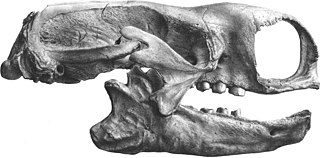
Mylodon is a genus of extinct ground sloth belonging to the family Mylodontidae, known from the Pampas and Patagonia in Chile and Argentina in southern South America. With a total length of 3 to 4 m, it is one of the best-known and largest representatives of the group. The oldest finds probably date to the Lower Pleistocene; however, most of the fossil remains date from the Upper Pleistocene period. One of the most important sites of this phase is the Cueva del Milodón in southern Chile. Shortly after, about 10,200 BP, Mylodon became extinct. At this point in time, it coexisted with the first human colonists in America.

Megatheriidae is a family of extinct ground sloths that lived from approximately 23 mya—11,000 years ago.

Mylodontidae is a family of extinct South American and North American ground sloths within the suborder Folivora of order Pilosa, living from around 23 million years ago (Mya) to 11,000 years ago. This family is most closely related to another family of extinct ground sloths, Scelidotheriidae, as well as to the extant arboreal two-toed sloths, family Choloepodidae; together these make up the superfamily Mylodontoidea. Phylogenetic analyses based on morphology uncovered the relationship between Mylodontidae and Scelidotheriidae; in fact, the latter was for a time considered a subfamily of mylodontids. However, molecular sequence comparisons were needed for the correct placement of Choloepodidae. These studies have been carried out using mitochondrial DNA sequences as well as with collagen amino acid sequences. The latter results indicate that Choloepodidae is closer to Mylodontidae than Scelidotheriidae is. The only other living sloth family, Bradypodidae, belongs to a different sloth radiation, Megatherioidea.

Scelidotheriidae is a family of extinct ground sloths within the order Pilosa, suborder Folivora and superfamily Mylodontoidea, related to the other extinct mylodontoid family, Mylodontidae, as well as to the living two-toed sloth family Choloepodidae. The only other extant family of the suborder Folivora is the distantly related Bradypodidae. Erected as the family Scelidotheriidae by Ameghino in 1889, the taxon was demoted to a subfamily of Mylodontidae by Gaudin in 1995. However, recent collagen sequence data indicates the group is less closely related to Mylodon and Lestodon than Choloepus is, and thus it has been elevated back to full family status by Presslee et al. (2019).
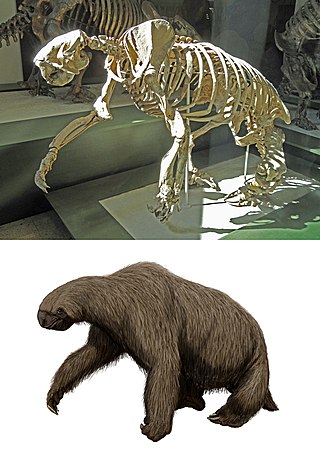
Megalonychidae is an extinct family of sloths including the extinct Megalonyx. Megalonychids first appeared in the early Oligocene, about 35 million years (Ma) ago, in southern Argentina (Patagonia). There is, however, one possible find dating to the Eocene, about 40 Ma ago, on Seymour Island in Antarctica. They first reached North America by island-hopping across the Central American Seaway, about 9 million years ago, prior to formation of the Isthmus of Panama about 2.7 million years ago. Some megalonychid lineages increased in size as time passed. The first species of these were small and may have been partly tree-dwelling, whereas the Pliocene species were already approximately half the size of the huge Late Pleistocene Megalonyx jeffersonii from the last ice age.

Glossotherium is an extinct genus of large mylodontid ground sloths of the subfamily Mylodontinae. It represents one of the best-known members of the family, along with Mylodon and Paramylodon. Reconstructed animals were between 3 and 4 metres long and possibly weighed up to 1,002.6–1,500 kg. The majority of finds of Glossotherium date from the Middle and Upper Pleistocene, around 300,000 to 10,000 years ago, with a few dating older, as far back Pliocene, about 3.3-3 million years ago. The range included large parts of South America, east of the Andes roughly from latitude 20 to 40 degrees south, leaving out the Amazon Basin in the north. In western South America, finds are also documented north of the equator. The animals largely inhabited the open landscapes of the Pampas and northern savanna regions.
Chubutherium is an extinct genus of ground sloth from the Late Oligocene and Early Miocene of Chubut Province, Argentina.
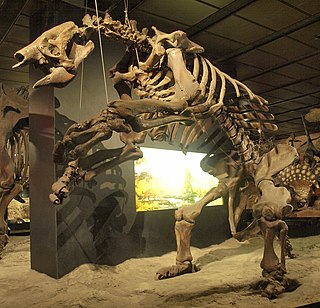
Eremotherium is an extinct genus of giant ground sloth in the family Megatheriidae. Eremotherium lived in southern North America, Central America, and northern South America from the Pliocene, around 5.3 million years ago, to the end of the Late Pleistocene, around 10,000 years ago. Eremotherium was widespread in tropical and subtropical lowlands and lived there in partly open and closed landscapes, while its close relative Megatherium lived in more temperate climes of South America. Both genera reached the size of today's elephants and were among the largest mammals in the Americas. Characteristic of Eremotherium was its robust physique with comparatively long limbs and front and hind feet especially for later representatives- three fingers. However, the skull is relatively gracile, the teeth are uniform and high-crowned. Like today's sloths, Eremotherium was purely herbivorous and was probably a mixed feeder that dined on leaves and grasses. Eremotherium was a generalist that could adapt its diet to the respective local and climatic conditions of many regions. Finds of Eremotherium are common and widespread, with fossils being found as far north as South Carolina in the United States and as far south as Rio Grande Do Sul in Brazil, and many complete skeletons have been unearthed.

Catonyx is an extinct genus of ground sloth of the family Scelidotheriidae, endemic to South America during the Pliocene and Pleistocene epochs. It lived from 2.5 Ma to about 10,000 years ago, existing for approximately 2.49 million years. The most recent date obtained is about 9600 B.P.
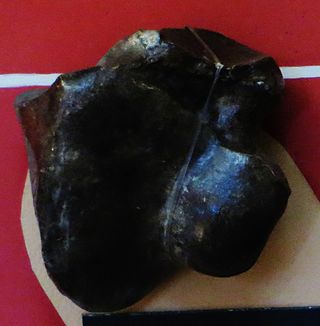
Octodontotherium is an extinct genus of ground sloth of the family Mylodontidae, endemic to South America during the Late Oligocene (Deseadan). It lived from 29 to 23 Mya, existing for approximately 6 million years.
Orophodon is an extinct genus of ground sloth of the family Mylodontidae, endemic to Argentina, South America.

Scelidodon is an extinct genus of South American ground sloths. Its remains have been found in the Yupoí and Uspara Formations of Argentina, the Ulloma, Umala, Ñuapua and Tarija Formations of Bolivia, in Brazil, in Chile and in Peru. The youngest fossils have been dated to as recently as 9000 B.P.
Miocnus is an extinct genus of ground sloths of the family Megalocnidae endemic to Cuba during the Pleistocene and very early Holocene epochs, living from 1.8 Mya—11,000 years ago, existing for approximately 1.789 million years.

Nothrotheriidae is a family of extinct ground sloths that lived from approximately 17.5 mya—10,000 years ago, existing for approximately 17.49 million years. Previously placed within the tribe Nothrotheriini or subfamily Nothrotheriinae within Megatheriidae, they are now usually placed in their own family, Nothrotheriidae. Nothrotheriids appeared in the Burdigalian, some 19.8 million years ago, in South America. The group includes the comparatively slightly built Nothrotheriops, which reached a length of about 2.75 metres (9.0 ft). While nothrotheriids were small compared to some of their megatheriid relatives, their claws provided an effective defense against predators, like those of larger anteaters today.

Valgipes is an extinct genus of scelidotheriid ground sloth, endemic to intertropical Brazil and Uruguay during the Late Pleistocene. Thought to have been a forest-dwelling browser, Valgipes is a monotypic genus with a complex and long taxonomic history, and is a close relative of Catonyx and Proscelidodon.

Megalocnidae is an extinct family of sloths, native to the islands of the Greater Antilles from the Early Oligocene to the Mid-Holocene. They are known from Cuba, Hispaniola and Puerto Rico, but are absent from Jamaica. While they were formerly placed in the Megalonychidae alongside two-toed sloths and ground sloths like Megalonyx, recent mitochondrial DNA and collagen sequencing studies place them as the earliest diverging group basal to all other sloths. They displayed significant diversity in body size and lifestyle, with Megalocnus being terrestrial and probably weighing several hundred kilograms, while Neocnus was likely arboreal and similar in weight to extant tree sloths, at less than 10 kilograms.
Archaeomylodon is an extinct genus of mylodontine ground sloths that lived during the Middle Pleistocene of what is now Argentina. It is known so far only from a single skull, which in its dimensions corresponds to those of the giant Lestodon. However, the skull differs from this one by its narrower and higher snout. In addition, the anterior canine teeth, which are usually large in many mylodonts, are greatly reduced. The find comes from the Pampa region of South America and was deposited in about 700,000 years old sediments.
Neonematherium is an extinct genus of scelidotheriid ground sloths that lived in Argentina, Chile, and Colombia during the Early to Late Miocene. Fossils have been found in the Honda Group of Colombia, and the Río Frías Formation of Chile.
Analcitherium is an extinct genus of scelidotheriid sloth that lived during the Early Miocene in what is now Argentina. Fossils have been found in the Santa Cruz Formation of Argentina.

Ortotherium is a genus of megalonychid ground sloth from the Late Miocene Ituzaingó Formation of Entre Rios Province, Argentina. Although many species were described, the only valid species of the genus is Ortotherium laticurvatum, with many species being junior synonyms. Ortotherium is known from very fragmentary material, all of which is material from the mandible and teeth. The holotype of O. laticurvatum consists of an incomplete left dentary that had been unearthed from a series of sediments known as ‘Conglomerado osifero’ in Paraná, Argentina. Argentina paleontologist Florentino Ameghino named the species in 1885, though he would go on to name four more, invalid, species of the genus. One species however, O. brevirostrum, has been reclassified as Mesopotamocnus.
